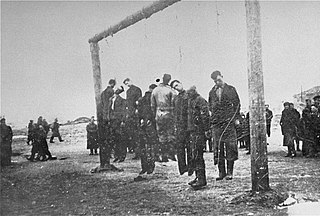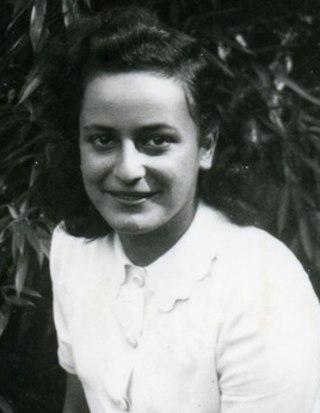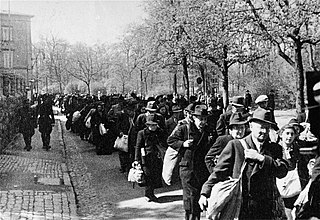This article needs additional citations for verification .(March 2014) |
This is a list of Holocaust victims whose writings were published posthumously.
This article needs additional citations for verification .(March 2014) |
This is a list of Holocaust victims whose writings were published posthumously.

The Warsaw Ghetto was the largest of the Nazi ghettos during World War II and the Holocaust. It was established in November 1940 by the German authorities within the new General Government territory of occupied Poland. At its height, as many as 460,000 Jews were imprisoned there, in an area of 3.4 km2 (1.3 sq mi), with an average of 9.2 persons per room, barely subsisting on meager food rations. Jews were deported from the Warsaw Ghetto to Nazi concentration camps and mass-killing centers. In the summer of 1942, at least 254,000 ghetto residents were sent to the Treblinka extermination camp during Großaktion Warschau under the guise of "resettlement in the East" over the course of the summer. The ghetto was demolished by the Germans in May 1943 after the Warsaw Ghetto Uprising had temporarily halted the deportations. The total death toll among the prisoners of the ghetto is estimated to be at least 300,000 killed by bullet or gas, combined with 92,000 victims of starvation and related diseases, the Warsaw Ghetto Uprising, and the casualties of the final destruction of the ghetto.

Camp Westerbork, also known as Westerbork transit camp, was a Nazi transit camp in the province of Drenthe in the Northeastern Netherlands, during World War II. It was located in the municipality of Westerbork, current-day Midden-Drenthe. Camp Westerbork was used as a staging location for sending Jews to concentration camps elsewhere.

Esther (Etty) Hillesum was a Dutch Jewish author of confessional letters and diaries which describe both her religious awakening and the persecutions of Jewish people in Amsterdam during the German occupation. In 1943, she was deported and murdered in the Auschwitz concentration camp.

The Łódź Ghetto or Litzmannstadt Ghetto was a Nazi ghetto established by the German authorities for Polish Jews and Roma following the Invasion of Poland. It was the second-largest ghetto in all of German-occupied Europe after the Warsaw Ghetto. Situated in the city of Łódź, and originally intended as a preliminary step upon a more extensive plan of creating the Judenfrei province of Warthegau, the ghetto was transformed into a major industrial centre, manufacturing war supplies for Nazi Germany and especially for the Wehrmacht. The number of people incarcerated in it was increased further by the Jews deported from Nazi-controlled territories.

Theresienstadt Ghetto was established by the SS during World War II in the fortress town of Terezín, in the Protectorate of Bohemia and Moravia. Theresienstadt served as a waystation to the extermination camps. Its conditions were deliberately engineered to hasten the death of its prisoners, and the ghetto also served a propaganda role. Unlike other ghettos, the exploitation of forced labor was not economically significant.

The Warsaw Jewish Cemetery is one of the largest Jewish cemeteries in Europe and in the world. Located on Warsaw's Okopowa Street and abutting the Christian Powązki Cemetery, the Jewish necropolis was established in 1806 and occupies 33 hectares of land. The cemetery contains over 250,000 marked graves, as well as mass graves of victims of the Warsaw Ghetto. Although the cemetery was closed down during World War II, after the war it was reopened and a small portion of it remains active, serving Warsaw's existing Jewish population.

The Lwów Ghetto was a Nazi ghetto in the city of Lwów in the territory of Nazi-administered General Government in German-occupied Poland.

Bodzentyn is a town in Kielce County, Świętokrzyskie Voivodeship, Poland, with 2,168 inhabitants as of December 2021. Bodzentyn belongs to Lesser Poland, and was granted town charter in 1355. The town lies in the Świętokrzyskie Mountains, here main office of the Świętokrzyski National Park is located.

Rut "Rutka" Laskier was a Jewish Polish diarist who is best known for her 1943 diary chronicling the three months of her life during the Holocaust in Poland. She was murdered at Auschwitz concentration camp in 1943 at the age of fourteen. Her manuscript, authenticated by Holocaust scholars and survivors, was published in the Polish language in early 2006. English and Hebrew translations were released the following year. It has been compared to the diary of Anne Frank.

Hélène Berr was a French woman of Jewish ancestry and faith, who documented her life in a diary during the time of Nazi occupation of France. In France she is considered to be a "French Anne Frank". She died of the of typhus during an epidemic of the disease in Bergen-Belsen concentration camp that also killed Anne Frank and her sister Margot.

Mordka Mendel Grossman was born on 27 June 1913 in Gorzkowice, Piotrków Governorate, Russian Empire. He died on 30 April 1945, during the death marches. He was a photographer and worker in the Statistical Department of the Litzmannstadt Ghetto.

Mary Berg was a survivor of the Warsaw Ghetto and author of a Holocaust diary, which contains her personal journal entries written between October 10, 1939, and March 5, 1944, during the occupation of Poland in World War II.
Rywka Lipszyc was a Polish-born Jewish diarist and Holocaust survivor. She was deported to Auschwitz-Birkenau concentration camp followed by a transfer to Gross-Rosen and forced labor at its subcamp in Christianstadt. She was then taken on a death march to Bergen-Belsen, and was liberated there in April 1945. Too ill to be evacuated, she was transferred to a hospital at Niendorf, where the record of her life ended.

David Kahane was a Polish-Jewish religious teacher, doctor of philosophy, member of the Mizrachi party in Lwów and Chief Rabbi of the Polish Army. He was also the Chief Rabbi of the Israeli air force, and Chief Rabbi of Argentina between 1965 and 1975.

The question of how much Germans knew about the Holocaust whilst it was being executed is a matter of debate by historians. With regard to Nazi Germany, some historians argue that it was an open secret amongst the population, whilst others highlight a possibility that the German population were genuinely unaware of the Final Solution. Peter Longerich argues that the Holocaust was an open secret by early 1943, but some authors place it even earlier. However, after the war, many Germans claimed that they were ignorant of the crimes perpetrated by the Nazi regime, a claim associated with the stereotypical phrase "Davon haben wir nichts gewusst".

Baranavichy Ghetto was a ghetto created in August 1941 in Baranavichy, Belarus, with 8,000 to 12,000 Jews suffering from terrible conditions in six buildings. From March 4 to December 14, 1942, Germans killed nearly all of the Jews in the ghetto. Only about 250 survived the war, some of whom were helped by Hugo Armann, head of a unit that arranged travel for soldiers and security police. He saved six people from a murder squad and another 35 to 40 people who worked for him. Edward Chacza coordinated escapes with Armann and others so that Jews would meet up with partisan groups in the forest. He also provided food and arms.